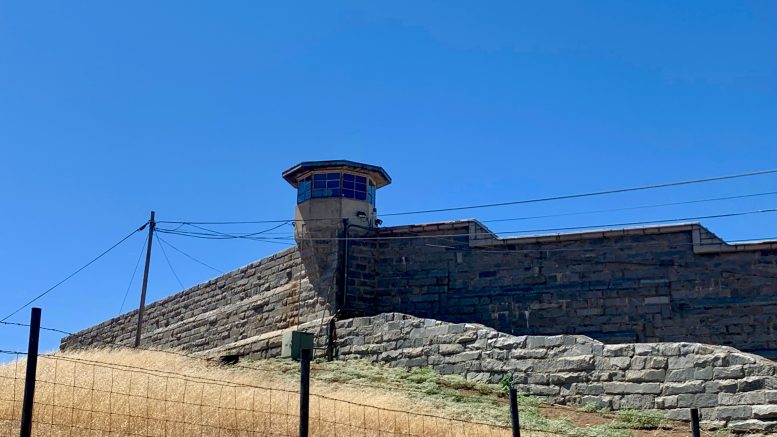By Byrhonda Lyons for CalMatters
As Gov. Gavin Newsom retools the state’s prison system to emphasize rehabilitation, his administration has little evidence that a privately run program for parolees costing taxpayers $100 million a year works to prevent future crime.
The state does not collect data on whether parolees who participate in the program have found jobs or whether they are returned to prison for another crime. What state data does show is that only 40% of participants completed at least one of the services they were offered.
The information gap frustrates critics of the governor’s policies as well as supporters who want evidence that the state’s investments are working.
“At the end of the day, we’ve come from 160,000 people incarcerated down to 95 (thousand). So we’ve had some success,” said Assemblymember Reggie Jones-Sawyer, a Los Angeles Democrat, referring to the decline in the state’s prison population since 2011.
“But I also want to ensure the public that they’ve been safe with all these people not recidivating… And the only way we can do that is to come up with data,” he said.
CalMatters’ yearlong investigation of the parolee reentry program draws on court records, state reports and data, contracts, tax forms, policy experts, interviews with vendors and communication with several current and former program participants — some of whom are back in prison.
CalMatters found:
Corrections department data is outdated, inaccurate or doesn’t exist. When the department provided CalMatters with a roster of more than 400 locations providing rehabilitation services, we visited 23 of them, finding some with inaccurate addresses, one with a padlocked gate in front of a seemingly closed site, another that appeared to be abandoned, and three where employees said they were no longer providing rehabilitation services.
Department officials struggled to explain how many people enrolled in the program in 2020-2021. The department published an annual report noting 17,650 participants. Dana Simas, a department spokesperson at the time, told CalMatters the program served 9,516 people. The department later revised that number to 8,213.
State data show only two out of five parolees who participated in the rehabilitation program in 2020-2021 completed at least one service offered to them. Based on how the state collects data, it’s unclear if anyone finished all of the services offered to them. A spokesperson said the corrections agency “is unable to provide further completion information.”
State officials rarely review the operations of the four companies that operate the program, state accountability reviews show. Records show state officials only documented reviews of three of the more than 400 state-funded reentry homes and treatment facilities from 2018 to December 2022.
Some of the nonprofit vendors that manage reentry homes lease their facilities from their own executives, according to public records, raising “red flags” among experts who say the arrangements could signal financial conflicts of interest.
The state’s July 2022 list of reentry homes included several with suspended business licenses and nonprofit status revoked years ago by the California Department of Justice — effectively barring them from doing business in California.
The rehabilitation program for parolees formally launched in 2014 under the name Specialized Treatment for Optimized Programming, often referred to as STOP. It is a voluntary program that serves less than a quarter of the roughly 35,000 inmates released from prison each year. Many of the parolees live at the homes; others visit outpatient centers.
The STOP program for parolees, which has cost the state about $600 million in the past decade, is run by four large contractors. Those companies also contract with nearly 200 nonprofits, private companies or community organizations to provide housing and rehabilitation services for parolees in roughly 450 homes and treatment centers.
All of the contractors told CalMatters that they were proud of the work that they do with the program.
“GEO Reentry Services is proud to operate California’s Specialized Treatment for Optimized Programming … on behalf of the California Department of Corrections and Rehabilitation,” wrote Monica Hook, GEO’s vice president of communications. “GEO Reentry connects participants in 18 counties with housing, education, and treatment services to support successful reentry and recidivism reduction.”
The California Department of Corrections and Rehabilitation officials ignored multiple requests for an interview.
Instead, a department’s public affairs official responded to emailed questions with emailed responses, and fulfilled many public records requests.
After CalMatters’ inquiries, department official Terri Hardy said by email that the department would begin to track recidivism and the employment rate among participants in the STOP and that it would prevent unlicensed vendors from managing reentry homes and treatment facilities.
Hardy also said by email the department is “currently working on a report that addresses STOP programs.” She added that the department said it has created a tool to “better track” whether the four primary contractors are conducting annual reviews of reentry homes and treatment facilities, which are required.
“CDCR understands the importance of oversight and accountability in this program,” Hardy said by email. “Since STOP was created in 2014, CDCR has continually worked to make the system better.”
Advocates for the program maintain it is a good investment for the state. They say it provides a soft landing for parolees who otherwise would be on their own and competing for scarce housing in California’s high-priced market.
Matthew Cate, whose company lobbies for several rehabilitation providers and who led the corrections agency under former Govs. Arnold Schwarzenegger and Jerry Brown, said reentry programs are often the best option for rehabilitating offenders.
“What the STOP program tries to do is…provide some community programs that are meant to address (parolees’) most severe needs.
“It’s very difficult to say whether it’s this program or that program that’s helping. And it’s also extremely difficult in terms of a scientific study, to say which of the programs that they’re not getting is the reason that they failed. … We’re trying to help each individual.
“It’s just very hard to measure.
“In fact, as someone who’s worked in this field for a long, long time … I know that it’s better than nothing,” Cate said.
Inconsistent programming

Absent state data on how well the program works, CalMatters reached out to roughly 150 inmates and parolees who were recently released from prison to learn about their experiences.
Some committed crimes and returned to prison soon after leaving the STOP program. Others felt the rules of the houses in which they lived limited their ability to find jobs. Some appreciated the time the program gave them in a structured environment, allowing them space to ease back into the civilian world after decades in prison.
Chad Doherty, 37, is among the parolees who washed out of the program and bounced back to prison.
He cycled in and out of San Bernardino County courtrooms for years before he was sent to prison in 2015, court records show. He was released in 2017 and sent to a state-funded reentry home.
“I held a job, got myself a car and I was working the program,” he wrote CalMatters.
But he didn’t stay long.
Doherty said he was kicked out of one home for threatening the operator, and left another when its 10 p.m. curfew would have kept him from working a job with a night shift. He left the program in February 2018, two months after joining. By 2019, he was back to prison.
Released early during the pandemic, Doherty stayed out of trouble a few months before he was charged with possessing narcotics, according to San Bernardino County court records.
A year later, court records show Doherty was charged with stealing a vehicle and eventually sentenced to four years in prison — time he’s currently serving inside California Men’s Colony State Prison in San Luis Obispo. Doherty told CalMatters he’d like another shot at the parolee rehabilitation program after his release.
“I was doing good when I was in control of my mind but at some point my mind started mastering me,” he told CalMatters. “And it mastered me right back into prison.”
The rehabilitation did not have a lasting impact on Jack Loney, either. Loney, 43, was released in 2020 and sent to a reentry program in Northern California after serving 23 years in prison for second degree murder, he told CalMatters.
The program “was great,” but after he finished, he began to unravel. He said he couldn’t find housing; had only a few months of paystubs; no rental or credit history; and fell back into “old patterns of thinking.” Within a year, Loney was serving time at Centinela State Prison in Imperial, back in prison after being arrested for possessing an illegal firearm, he told CalMatters.
Former participant Tammy Cooper-Garvin felt the months she spent in the program four years ago, at a women’s treatment home in San Francisco, was a waste of time.
“The program, excuse me, was (expletive) up,” Cooper-Garvin said. “I had to sneak and get a job … at Target.” She added that the site where she lived tolerated drug use and violence.
Another parolee who wanted to remain anonymous because he fears retaliation from his landlord, is finding the program difficult to navigate. As a condition of his release, he has to live in a reentry home, and the parolee program is his only option that would not charge him rent and other fees.
The corrections department “just stuck me in (the program), so I have to fulfill their requirements, like go to group … in a whole other city where I have to catch three buses,” he said.
One former prisoner said rehabilitation gave him a chance to get on his feet, an opportunity he didn’t have when he was in and out of prison as a young man.
After spending two decades in prison, Eugene Lewis lived in a home he shared with other parolees. He spent his mornings doing chores and his days in group therapy sessions and self-help classes.
“I’ve never been in any halfway house or reentry,” said Lewis, who said he was required to stay as a condition of his release. “It’s great. I have no complaints.” A few months later, he told CalMatters that he wasn’t as excited about the program as he once was — but didn’t say why. Lewis left the program in June 2023.
Four contractors in charge of parolee program
What happens in the homes is largely up to the four contract operators hired by the state. The companies divide the state by regions and hire hundreds of nonprofits and for-profit companies to run the homes and treatment centers. State records show:
Amity Foundation, also known as Epidaurus, is an Arizona-based nonprofit that provides rehabilitation services for parolees and prisoners. Amity in 2018 began overseeing parolee reentry providers in Los Angeles County. It signed a a five-year, $121 million agreement that expired June 30.
GEO Reentry Services, a Florida-based for-profit company known for its private prisons, has two contracts to manage providers in Riverside and San Bernardino counties, the Bay Area and the Central Coast, totaling $195 million.
HealthRight 360 is a San Francisco-based nonprofit. It signed a seven-year, $80 million contract with the state to manage reentry subcontractors in Imperial, Orange and San Diego counties.
WestCare California is a Nevada-based nonprofit that the state pays to manage programs in the Central Valley and Northern California. WestCare signed two seven-year contracts, totaling $189 million.
All of the companies have turned to high-powered former leaders of California’s prison system to help them lobby in the Capitol and/or set direction on executive boards.
Former California Corrections Secretary Scott Kernan left the agency on Aug. 31, 2018. Ten days later, Kernan was appointed to the GEO Group’s board of directors, a company filing with the Securities and Exchange Commission shows.
Former Corrections Secretary Cate left the agency in 2012. He had several roles before helping launch Mosaic Solutions and Advocacy. His company started lobbying for the Amity Foundation, HealthRight 360 and WestCare California in the 2021-2022 legislative session.
During that time, Amity Foundation spent $230,000 to lobby the Legislature, with $45,000 going to Mosaic. WestCare California paid Mosaic some $51,000 and HealthRight 360 paid the company $27,500 to lobby on its behalf, state lobbying records show.
Hands off oversight

The four contractors are required to annually inspect and create a report on their subcontractors. In addition, state employees are supposed to “conduct routine Program Accountability Reviews (PAR) of contractors and/or subcontractor facilities,” contracts show. The contracts give no timeline for the state’s review.
An analysis of the reports shows that the accountability reviews do not happen annually, as the contract requires. Furthermore, state officials did not write any program accountability reviews for the four contractors between 2018 and December 2022, and only reviewed three out of hundreds of its subcontractors, state records show.
Amity has reviewed its own facilities at least twice, once in 2019 and once in 2021. The corrections agency itself had not written any program accountability reviews of Amity sites when CalMatters requested them.
Asked if this practice was a conflict of interest, Amity’s chief operations officer Carmen Jacinto responded by email: “Annual Program Accountability Reviews of subcontractors … may be conducted by Amity or CDCR. … Even in situations where CDCR does not select our sites for a formal evaluation, Amity will conduct self-audits and report on them.”
In the Central Valley, WestCare California often detailed what its subcontractors were doing right and their shortcomings. In 2021, it inspected one of its vendors in Atwater and found there “hadn’t been a licensed clinician” at a women’s facility in nearly two years, even though the contract required it, according to a program accountability report. Treatment costs at the facility ranged from $2,250 to $12,000 for a 30-day stay, the contract shows.
In other treatment homes, WestCare reported that several of its subcontractors were allowing unapproved staff to work, not providing enough group therapy hours, not accurately tracking therapy times, and not documenting drug screens.
But WestCare does not appear to have applied the same scrutiny to the properties it runs directly. Neither the nonprofit nor the state corrections agency wrote accountability reviews of WestCare facilities, records show.
WestCare did not respond to CalMatters’ questions about its program review process.
“(The state) gives these people a lot of money, but they don’t check into the program,” said one resident who currently lives in a home overseen by GEO Reentry, who wanted to remain anonymous because he said he fears retaliation from his landlord . “There’s no programming inside the house…just free room and board.”
The corrections agency in November released to CalMatters its July 2022 list of providers for the STOP program. The roster included roughly 400 addresses. CalMatters visited 23 of them, finding a padlocked gate in front of a seemingly closed site, inaccurate addresses, a facility that appeared to be abandoned and three where employees said they were no longer STOP providers.
Hardy, the corrections department spokesperson, said its contractor shut down the vacant site three days before CalMatters visited the property in February. According to the state, HealthRight 360 closed the location because it could not keep the 72-bed facility full. Hardy said the state provides oversight in various ways such as, “monitoring the referrals, placements, data reports, and budgets.”
CalMatters asked why the facilities are not reviewed annually as required by their contracts. Hardy replied via email on Jan. 27: “We are developing functionality in our Automated Reentry Management System that will allow us to better track whether contractors conduct annual (program accountability reviews) of their subcontractors. The … tool is completed and (program accountability reviews) are anticipated to be conducted in early 2023.”
The tool had not been used as of June, said Hardy.
What does it cost?
Small nonprofit organizations and big contractors charge a range of fees for the services they provide to parolees.
WestCare California’s contracted services for licensed substance use disorder treatment can run taxpayers between $2,250 and $12,000 per person each 30 days. GEO Reentry Services can charge between $3,900 and $6,600 for the same service, and HealthRight 360’s prices range from $3,000 to $9,000, state contracts show.
For recovery and reentry housing alone, WestCare California in the Central Valley and HealthRight 360 in Imperial, Orange and San Diego counties charge between $900 and $6,000 per person, according to their contracts. GEO Reentry in Riverside and San Bernardino counties charges between $1,350 and $3,450. Amity Foundation, which covers Los Angeles county, charges between $1,092 and $2,860, records show.
Throughout the program, CalMatters found several instances where businesses and nonprofit groups lease properties personally owned by their executives, according to tax statements and property deeds. CalMatters found this practice in every region of the program, and though not illegal, it could present a conflict of interest, one expert said.
Yellowstone Women’s First Step House, a subcontractor of HealthRight 360, leases properties connected to its CEO and board member emeritus, Dr. Anna Thames. HealthRight’s most recent tax filing shows it is paying Yellowstone $1.6 million for rehab services in 2020.
CalMatters found that four of the eight Yellowstone facilities listed on the department’s roster of STOP providers are owned by Thames, or a trust for which she is the trustee. In 2021, Yellowstone had five month-to-month leases with its CEO, renting seven buildings at “approximately $29,000” per month. In all, the company paid Thames $260,386 for rent and an additional $168,002 for compensation, and owed her $154,267 in rent at the end of 2021, according to nonprofit financial records filed with the California Department of Justice.
Nonprofit expert Nora Silver noted that in some cases using personally held properties may be the only way to ensure people with a criminal record have a place to stay.
Even so, she said, it’s a practice nonprofits should stay away from because it could give a leader a personal financial stake in the work of the organization.
“If board members or a CEO or executive director has a financial interest in some work the organization is doing, that’s a red flag,” said Silver, founder and faculty director at UC Berkeley’s Center for Social Sector Leadership. “There’s room for conflict of interest and that’s serious.”
CalMatters spoke over the phone with a person who identified herself as Anna Thames. “I’m in a meeting right now,” she told CalMatters’ reporter before agreeing to call back. She has not returned the call or responded to follow up calls.
California’s changing prisons

California’s spending on the parolee program swelled over a decade of reform in the state’s prison system, when Govs. Brown and Newsom backed policy changes that shortened criminal sentences and steered more resources to rehabilitation.
The new policies slimmed down California’s overburdened system, allowing Newsom to close a prison and begin shutting down three more.
But the two Democratic governors and state lawmakers have not compelled the corrections agency by law to track whether the new rehabilitation services are helping former inmates stay out of prison.
Recidivism, by the state’s definition, occurs when someone is “convicted of a new felony or misdemeanor within three years of being released from custody” or placed on supervision for a previous criminal conviction.
California discloses recidivism data on a three-year cycle but the latest report is outdated. In fact, the most recent report describes people who were released from prison in 2017-18 — before Newsom took office.
“Almost nothing we do has any evidence suggesting that it works,” said Michael Romano, director and founder of the Three Strikes Project at Stanford Law School. “In fact, much of what we do routinely, we have evidence that shows it does not work. It’s a problem well beyond STOP that they don’t have evidence that it works. I don’t think the (corrections agency) has any evidence that any of its programs — or any of its punishments — work or don’t work.”
For years, the recidivism rate has hovered around 46%, the most recent state report shows. The data show only 700 inmates out of about 35,000 released that year earned credit for participating in rehabilitation programs while in prison. They had a substantially lower recidivism rate — 23% —than those who did not.
There have been two detailed but narrow investigations into California prison rehabilitation programs. One in 2021 by Stanford researchers concluded that inmates who serve the last year of their sentences confined in a community-based rehabilitation program outside of a prison reduce their likelihood of getting arrested within a year of release by 13%.
A separate report by the California State Auditor in 2019 found that prisoners who completed recommended cognitive-based therapy rehabilitation programs recidivated at about the same rate as those who did not. The auditor recommended six legislative actions for lawmakers to ensure rehabilitation programs set performance targets and reduce recidivism.
Lawmakers have not made many of the recommended changes.
The Legislature in 2019 passed a bill that would have required an evaluation of in-prison rehabilitation. Newsom vetoed it, writing in his veto message, “the goal of this bill can be accomplished administratively.”
Now, the corrections agency is working with the Public Policy Institute of California to review the effectiveness of in-prison programming. The institute began receiving state data last year.
“What we are trying to do … has not been done anywhere in the country,” said Heather Harris, a criminal justice research fellow at the Public Policy Institute of California. “I wish we had better information to offer incarcerated people and policymakers…now. But we don’t.”


Be the first to comment on "California spent $600 million to house and rehab former prisoners — but can’t say whether it helped"